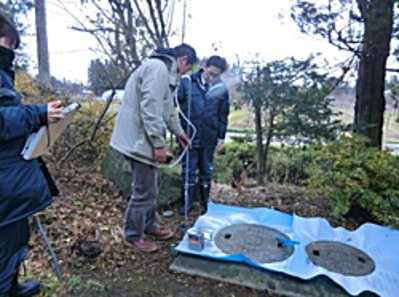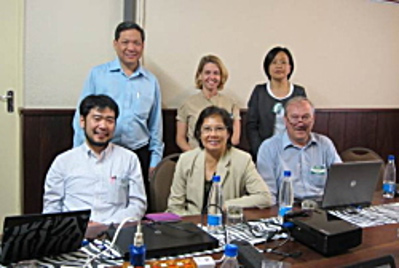- Waste management in Japan
- Circular economy in Japan
- Waste management in Asia
- Disaster waste management
Initiatives for Improving Accuracy in the Calculation of Greenhouse Gas Emissions
Countries use different methods for calculating GHG emissions
Emissions of greenhouse gases (GHGs), such as carbon dioxide (CO2) and methane (CH4), are calculated by multiplying "activity data" which is the quantified amount of a human activity (e.g. production, consumption, and incineration) by its corresponding coefficient called "emission factor" which is GHG emissions per unit human activity. For example, GHG emissions resulted from domestic wastewater treatment are calculated from the amount of domestic wastewater treated by the method or the population using the method. In Japan, domestic wastewater treatment methods are roughly categorized into three: (1) centralized sewage treatment system, (2) Johkasou (decentralized wastewater treatment system mainly for individual houses), and (3) night soil treatment system consisting of vault toilets at individual houses and centralized night soil treatment plants. Statistics on domestic wastewater treatment are available in Japan, and GHG emissions are calculated from these statistical data. However, some developing countries have neither sewage treatment systems nor proper decentralized treatment technologies such as Johkasou. Some parts in these countries may not even have toilets. In addition, countries use different methods with different precisions to produce statistics. There are cases that lack the user population data.
For the reasons mentioned above, the Intergovernmental Panel on Climate Change (IPCC) has published guidelines (external link) for GHG emission calculations. The guidelines offer various GHG estimation methods, from simple ones to the most advanced ones containing country-specific models and actual measurement values. Countries can choose from them a method that suits their own conditions. The guidelines also provide region-wise default emission factors and ratios of user population for each treatment method. Any country which faces difficulties in obtaining actual data and information can use these default values.
Thus, GHG emissions are calculated by applying the science-based methodologies from the IPCC guidelines even though each country selects a different method.
Toward more accurate GHG emission calculation
The IPCC guidelines encourage the use of country-specific data as much as possible in order to improve the accuracy of GHG emission calculations. The use of actual data is important because it will result in more accurate estimation of global GHG emissions. It will also help each country review effective GHG reduction measures. In Japan, the emission factors are specified for sewage treatment, Johkasou, and night soil treatment systems respectively. They were determined by the Committee for the GHG Emission Estimation Methods of the Ministry of the Environment based on various scientific literatures and survey data. These emission factors specific to Japan, take into consideration the country's own domestic wastewater volumes, pollution concentrations, and the treatment methods used. Japan therefore uses a relatively advanced calculation method, but these emission factors are based on the research results from the early 1990s, and recent technological development and changes in people's lifestyles may have changed them. In view of the above, we have been conducting field surveys to collect actual emission data from existing domestic wastewater treatment facilities such as Johkasou as an attempt to improve the accuracy of GHG emission calculations.

Consideration of new scientific knowledge
The latest IPCC guidelines (as of February 2013 when this article was published) were published in 2006, and they refer to research papers and data from a few years back. Thus, in order to add new scientific information to them, it was decided to develop additional guidelines (or "supplement") on wetlands consisting of seven chapters. I have been participating in this work as a coordinating lead author of Chapter 6: Constructed Wetlands for Wastewater Treatment.

This supplement will be published in 2013. Since October 2011, contributors from all over the world have met in a series of meetings convened in different locations, namely Hayama (Japan), Edinburgh (Scotland), Victoria Falls (Zimbabwe), Dublin (Ireland), and Freising (Germany), to discuss its content. Each chapter is drafted by a team of contributors: two coordinating lead authors, several lead authors and review editors, and other authors selected as necessary. One coordinating lead author is selected from developing countries and the other from developed countries so that the calculation methods presented in the guidelines will become applicable to all countries at different stages of development. Everyone contributes to the supplement from a purely scientific point of view with no possible conflict of interest. Although their participation is voluntary, the contributors can also gain new knowledge and better understanding of the conditions and perspectives in other countries, and benefit from the work. In fact, various comments have been provided by the participants during the meetings, which makes other participants to become aware of these conditions in different parts of the world.
At the time of this writing, revision of the initial draft supplement has been discussed and confirmed to be ready for the external expert review of the second draft. Please visit the IPCC 2013 Wetlands Supplement website below, if you are interested in our work.


